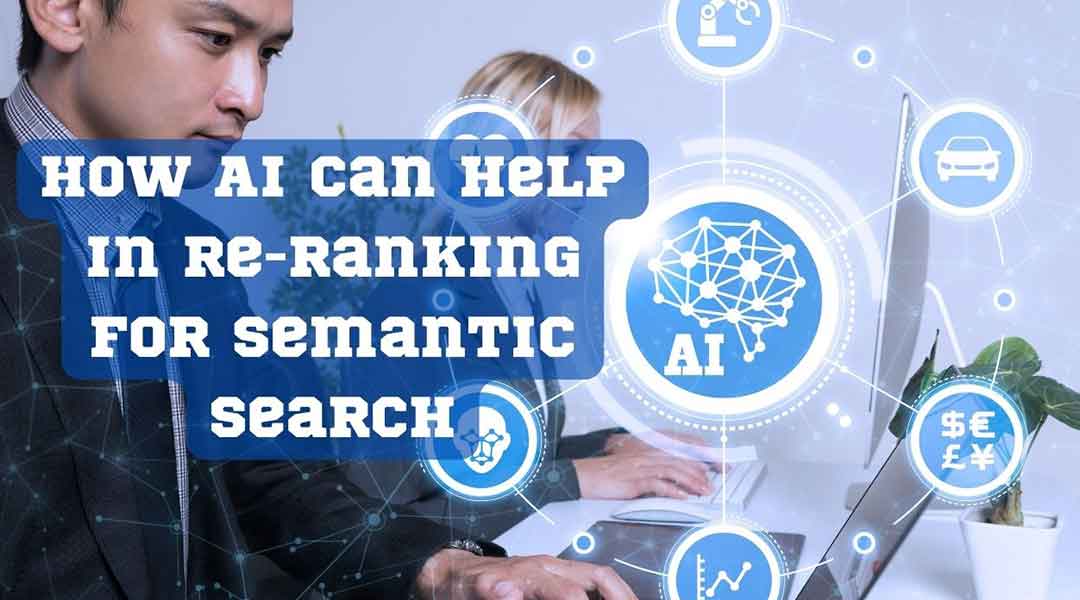Imagine having the exact answers you need at your fingertips; AI is elevating search engines to achieve just that, setting a new standard for online discovery. AI steps in to take semantic search to the next level by intelligent re-ranking. It’s time to ditch the surface level; we’re trying to grasp the underlying reasons behind each search.
With AI on our side, we can finally revamp search results to bring users what they’re really looking for. Semantics is where things get really interesting—you’ll get a grip on the underlying mechanics and meet the futuristic tools leading the charge.
Re-ranking challenges turn into opportunities when AI steps in, offering unique benefits yet introducing some implementation hurdles. A vibrant area is ripe for exploration indeed! Want to know the secret to making search more intelligent? It starts with understanding the intricacies of semantic search.
Understanding Semantic Search
Semantic search represents a critical shift in how search engines understand user queries, leveraging the context and intent behind words rather than just matching keywords. It brings into play Natural Language Processing (NLP) and Machine Learning (ML), which help algorithms grasp the nuanced meanings of terms based on their relationship with other words or phrases used in a query. This process mirrors human conversation, where context guides interpretation.
For instance, if you were to type “restaurants” into Google, semantic technology factors in your location, previous searches, and current trends deliver personalized results that match your implicit needs. The importance of semantic understanding for businesses cannot be overstated, as it significantly enhances site relevancy for users by focusing on delivering precisely what they seek. It does this by analyzing prior interactions.
To offer outcomes tailored to individual tastes or preferences even when faced with vague requests or typos. Adopting strategies aligned with semantic search ranking is vital because it ensures that your content reaches the right audience.
This approach maximizes engagement potential and conversion rates. As technologies evolve aimed at improving user experience through deeper contextual comprehension, websites must adapt these advancements promptly to stay competitive while offering unmatched value during each visitor’s journey.
The Role of AI in Semantic Search
As search habits evolve, AI plays a crucial role in semantic search by understanding and predicting user needs. This ensures users find the most relevant content for their queries.
- Semantic search transforms how engines interpret queries thanks to AI innovations like RankBrain and BERT. These tools help break down complex language patterns or new phrases, making it easier for algorithms to match intent with accurate results.
- User engagement metrics such as click-through rates (CTR) and bounce rates influence the re-ranking of pages in real time. If data shows that visitors aren’t finding what they’re searching for on a page, the engine can adjust rankings accordingly.
- For SEO professionals, adapting content strategies is essential. Prioritizing quality information focused on answering specific questions leads to improved visibility. Understanding the right contexts when optimizing allows you to connect more effectively with your audience’s searches.
Re-Ranking in Search Results: Challenges and Opportunities
Re-ranking in search results presents challenges yet offers significant opportunities to improve how users interact with online information. By timely adjusting the order of search outcomes, re-ranking algorithms aim for enhanced relevance and user satisfaction.
- Scalability Challenges: Re-ranking requires complex computations.: Complexities arise as systems attempt to blend multiple ranking signals efficiently. This process demands high computational resources, posing scalability issues while striving to keep response times quick. The necessity for optimized algorithms becomes evident here, ensuring that performance doesn’t suffer despite these demanding operations.
- Addressing Bias and Fairness: A tightrope walk.: Combining various data sources introduces the risk of amplifying existing biases within those datasets. Ensuring fairness in ranked results thus represents a pivotal concern for developers behind meta-ranking systems. Efforts must focus on creating unbiased models that still deliver personalized content without discriminating against specific groups or viewpoints.
- Privacy Considerations Take Center Stage: With personalization at its core, reranking relies heavily on user data collection and analysis—raising flags about privacy infringements and potential consequences that need careful consideration. Balancing between tailoring individual experiences and safeguarding user confidentiality marks a crucial strategy area requiring sensitive handling policies alongside advanced technological solutions to protect identities effectively while providing value through customization efforts based on behavior patterns observed from interactions across digital platforms.
How AI Powers Re-Ranking for Semantic Search
When shoppers look for a red dress, their actions—clicks and purchases—provide essential feedback. These behaviors should guide search engine re-ranking to prioritize more relevant results.
- Clicks and conversions are key signals for semantic search re-ranking. Tracking these from actual searches offers clear insight into user preferences. For instance, if users frequently choose summer dresses over options with only red accents, the algorithm adjusts to rank those higher.
- The concept of freshness combats the issue of top results cementing their positions due to continual selection by new users. Reducing the influence of past events over time—for example, halving an event’s impact daily up until it becomes irrelevant after 30 days—ensures timely and contextually appropriate recommendations.
- Learning To Rank (LTR) introduces significant flexibility by leveraging machine learning techniques not just on direct query-result interactions but across broader data sets. This allows for generalization beyond specific queries or records, thus accommodating seasonal trends or emerging interests without directly tying them back exclusively to individual search terms or immediate site activity history.
Tools and Technologies Driving AI-Powered Re-Ranking
You need to focus on tools and technologies that make your content fit better for AI-driven search engines. First off, identify what users are looking for with tools like Google’s Keyword Planner or Ahrefs. These platforms help you pinpoint the exact queries driving traf, ic; tus, enhancing your chances to rank higher in semantic searches.
Next step: integrate related keywords naturally into your content. This not only aids in traditional SEO but significantly boosts comprehension by AI algorithms examining contextuality. Use short paragraphs and bullet points to improve the clarity and accessibility of information. Consider using Grammarly’s premium version to ensure language simplicity without compromising quality.
Don’t overlook outdated material, either. Regular updates signal to AI that your content remains relevant, feeding its constant quest for fresh data, which enhances visibility in search results over time. Structure is key when arranging data within a piece of writing.
Employ lists or tables where feasible and use headings cleverly as signposts.
Benefits of AI-Driven Re-Ranking in Semantic Search
AI-driven re-ranking in semantic search is a significant leap forward, enhancing how users interact with search engines and improving the relevancy of results. This technology focuses on understanding user intent and context rather than just matching keywords.
- Enhanced Accuracy: Semantic search boosts result accuracy by interpreting the searcher’s true intentions. No longer will you see unrelated links cluttering your screen. Instead, expect pinpointed answers to your queries, cutting down on time spent digging through irrelevant information.
- Personalization: This method tailors results based on individual searching habits and history. If you frequently look up vegetarian recipes, for instance, those will pop up first in future searches related to food or dining out suggestions that align with your preferences.
- Time Efficiency: By delivering more relevant results faster, AI-driven semantic search significantly reduces the time needed to find useful information online—a change everyone can appreciate from busy professionals seeking quick data access to students doing research for assignments.
Challenges in Implementing AI for Re-Ranking
Implementing AI for reranking in semantic search encounters a few hurdles. First, choosing the optimal L1 configuration poses a significant challenge. Azure AI Search offers multiple options: text-based, vector-based, and hybrid configurations that merge both using Reciprocal Rank Fusion (RRF).
While our focus has been on hybrid searches due to their high baseline effectiveness, we’ve noticed even more substantial improvements with vector-only or text-only bases. Another complexity involves breaking up documents into 1024 token chunks as part of the process. This size is common among users but requires precise handling to ensure each chunk’s relevancy remains intact without overlap in analysis.
These steps are crucial for enhancing search outcomes yet demand careful implementation and continuous refinement to leverage fully the potential benefits of AI-powered reranking.
Best Practices for Leveraging AI in Re-Ranking
AI in re-ranking is all about refining search results to match user intent more closely. As an SEO and marketing expert with two decades of experience, I’ve seen firsthand how leveraging AI can significantly improve semantic search outcomes. Here are three best practices for doing just that:
- Be Simple Yet Specific: Writing content that’s both uncomplicated and laser-focused works wonders for AI-driven searches like Gemini. These systems prioritize responses directly tied to the query without unnecessary details. So when creating or updating your content, aim for clarity and precision—directly answer what was asked without veering off topic.
- Regular Content Refreshes: Keeping your website’s information up-to-date plays a crucial role in maintaining relevance in AIO rankings. But there isn’t a one-size-fits-all schedule for updates; it depends on new insights you gain or changes within the topics you cover. Revising evergreen pieces regularly by integrating recent examples or findings will make them even more valuable over time.
- Check against different purposes: While writing, remember AIO provides quick context, whereas SEO focuses on depth and relevancy across web pages. Fit into their unique criteria is important. Marketers must balance immediate answers suitable for generated queries with comprehensive details favored by traditional seo strategies. This delicate balancing act ensures success regardless of which route takes precedence during a specific search query.
Wrapping up, it’s clear that AI offers significant advantages for semantic search re-ranking. By addressing common SEO challenges such as developing topical authority, increasing domain authority through strategic link building, enhancing content quality, and smartly targeting less competitive keywords, businesses can greatly improve their online visibility. Remember to leverage AI-powered tools wisely; they’re not a magic fix but rather powerful assistants in your SEO toolkit.
Tools for content planning help identify gaps and suggest topics likely to boost niche standing. Meanwhile, article writers powered by AI save time on initial drafts or specific sections of content. Research assistants bring depth and fast access to industry news and data essential for standout articles.
Lastly, optimization tools analyze your pages against competitors’, offering actionable insights. To truly make an impact in today’s crowded digital landscape requires more than just following trends. It demands innovation and genuine value creation based on solid data analytics provided by state-of-the-art technology like artificial intelligence.
Alright, grappling with semantic search isn’t as daunting when AI steps into the picture. This clever tech sifts through heaps of data to grasp user intent. It spots patterns we mere mortals might miss.
Plus, it updates rankings by understanding nuanced language changes over time. So, for brands aiming at top slots in search results, using AI means staying ahead. With fresh insights and fine-tuning capabilities, it’s easier than ever to cater precisely to what users seek online—making every search hit the mark closer each time.










2 comments
Sarina Hermiston
November 23, 2022 at 12:05 pm
I like the idea of using the LTR (learn to rank) technique. However, this technique is truly complex and needs a lot of expertise to be able to rank in a good direction.
Jeffrey Butterfield
November 25, 2022 at 3:04 pm
What a lot of people don’t realize is that there are certain ways in which you can use AI to re-rank content for more clicks and conversions. This article shows you how to do it!
Comments are closed.